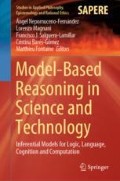Abstract
By means of an epistemological analysis of the internal components of default reasoning, and revisiting Geffner’s proposal about causal asymmetries, it is given in this paper an answer to the problem of soundness in default reasoning. The kernel of that answer is an intentionalist view of certain kind of connections inside the internal structure of a default rule. This intentionalist view consists partially in assuming certain strong relationships between the prerequisite, the justifications and the conclusion in a default. Another ingredient of this perspective is the distinction between the context-dependence of a relationship and that of its relatas. It is offered a formal representation of the internal structure of default reasoning. Then it is built an intuitive characterization of the notion of default logical consequence. This notion is similar to the traditional notion in the sense that it attends to the challenge of clarifying the inferential mechanism of a schema, even when in the present paper the proposal differs from the traditional one.
Access this chapter
Tax calculation will be finalised at checkout
Purchases are for personal use only
Notes
- 1.
Geffner, p. 3.
- 2.
Idem.
- 3.
This is a very well-known case, called the “Yale shooting problem”.
- 4.
Geffner, p. 95. Italics in the original. The distinction between to be evidence and to explain is attributed to Pearl by Geffner. The paper is: Pearl, J., Embracing causality in default reasoning. Artificial Intelligence, 35, 1988.
- 5.
There is a little misprint in the text of Geffner here: what appears as ¬alive’’ in the original ought to be alive’’ (without negation). I am writing it without negation.
- 6.
The emphasis is mine.
- 7.
Geffner, p. 96.
- 8.
- 9.
[1] p. 89.
- 10.
Idem.
- 11.
[1] p. 93. The example is put in the body of the text, in the penultimate paragraph on page 93, after the proof of the theorem 2.6.
- 12.
[1] pp. 81–86.
- 13.
About this alternative, and this example, I am in debt with an anonymous referee of my paper. I had not thought this possibility before her/his direct suggestion.
- 14.
A first version of this intentional strategy, appeared in [7], but related with the discussion about scientific explanation.
- 15.
In [8] other possible modifications on the proviso are suggested. They are called “modulations”.
References
Reiter R (1980) A logic for default reasoning. Artif Intell 13:81–132
Reiter R, Criscuolo G (1981) On interacting defaults. In: Drinan A (ed) Proceedings of the seventh IJCAI conference, Vancouver, Canada, pp 270–276
Geffner H (1992) Default reasoning: causal and conditionals theories, 1st edn. MIT Press, Cambridge
Achinstein P (1983) The nature of explanation, 1st edn. Oxford University Press, Oxford
Van Fraassen BC (1980) The scientific image. Oxford University Press, Oxford
Gómez Torrente M (2004) La noción de consecuencia lógica. In: Orayen R, Moretti A (eds) Filosofía de la Lógica, vol 27. Enciclopedia Iberoamericana de Filosofía, Trotta, Madrid
Gaytán D (2014) Un modelo no monotónico y paraconsistente de explicación científica. Ph.D. thesis, Universidad Nacional Autónoma de México, UNAM, México
Gaytán D, D’Ottaviano IM, Morado R (2018) Provided you’re not trivial. Adding defaults and paraconsistency to a formal model of explanation. In: Carnielli W, Malinowski J (eds) Contradictions, from consistency to inconsistency. Trends in logic, vol 47. Springer, Switzerland
Acknowledgements
This research was benefited from the PAPIIT-UNAM project “Non Classical Logics and Argumentation in Science”, IN401619; as well as from the discussions carried out in the Special Interest Group in Non-Monotonicity, SIGNO-MON, UNAM; and in the group of Formal Epistemology and Non Classical Logics of the Research Program in Science and Philosophy, PRINCIPHIA, UACM.
Author information
Authors and Affiliations
Corresponding author
Editor information
Editors and Affiliations
Rights and permissions
Copyright information
© 2019 Springer Nature Switzerland AG
About this paper
Cite this paper
Gaytán, D. (2019). Default Soundness in the Old Approach: An Epistemic Analysis of Default Reasoning. In: Nepomuceno-Fernández, Á., Magnani, L., Salguero-Lamillar, F., Barés-Gómez, C., Fontaine, M. (eds) Model-Based Reasoning in Science and Technology. MBR 2018. Studies in Applied Philosophy, Epistemology and Rational Ethics, vol 49. Springer, Cham. https://doi.org/10.1007/978-3-030-32722-4_21
Download citation
DOI: https://doi.org/10.1007/978-3-030-32722-4_21
Published:
Publisher Name: Springer, Cham
Print ISBN: 978-3-030-32721-7
Online ISBN: 978-3-030-32722-4
eBook Packages: Religion and PhilosophyPhilosophy and Religion (R0)

